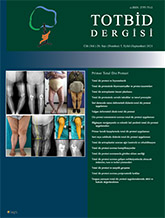
Although rarely seen, periprosthetic fracture around the knee is the most common among all periprosthetic fractures. Periprosthetic fractures are more common because of the increasing number of total knee replacement, postoperative activity level, and life expectancy. These fractures are seen in the femur, tibia and patella respectively, according to their frequency. The aim of treatment is union of fracture, maintenance of pre-fracture knee range of motion, and to obtaining a pain-free knee joint. Even though non-surgical treatment modalities are preferred in suitable patients, there is an increase in surgical treatment with advances in implant technology. On the other hand, no definite algorithm is present for treatment these fractures although increased studies recently in the literature. The treatment approach is based on the surgeon`s knowledge and experience about trauma and arthroplasty. In the management of these fractures, the surgeon should consider many factors such as the type of fracture, the status of the prosthesis, bone quality, soft tissue and the general condition of the patient. In this review, current informations about the etiology, classification and treatment options of periprosthetic fractures after total knee arthroplasty is presented.